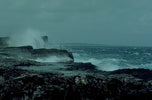
Weathering the Storm: A Guide to Spotting and Safely Navigating Bad Weather at Sea
, by Safe Water Team, 3 min reading time

, by Safe Water Team, 3 min reading time
Out on the open sea, where the horizon stretches endlessly in every direction, the weather can change in the blink of an eye. What starts as a clear, sunny day can quickly give way to dark clouds, rough seas, and powerful storms. For sailors and boaters alike, being able to recognize the signs of bad weather and knowing how to respond is essential for staying safe on the water. In this guide, we'll explore some key strategies for spotting and navigating bad weather while at sea.
Before heading out on your voyage, take the time to familiarize yourself with the weather patterns and conditions specific to your region. Different areas are prone to different types of weather phenomena, such as squalls, thunderstorms, or fog. Pay attention to local weather forecasts and advisories, and be prepared to adjust your plans accordingly based on the information available.
One of the oldest and most reliable methods for predicting weather at sea is simply observing the sky. Keep an eye out for changes in cloud formations, as certain types of clouds can indicate impending storms. Dark, towering cumulonimbus clouds, for example, often herald the approach of thunderstorms, while low, thick stratus clouds may signal the onset of fog or drizzle. Additionally, pay attention to the color of the sky—sudden shifts in hue, such as a reddish or yellowish tint, can be a warning sign of approaching inclement weather.
Wind and wave patterns can provide valuable clues about the current and future weather conditions. Sudden changes in wind direction or speed, for instance, may indicate the presence of a nearby weather system. Likewise, keep an eye on wave height and frequency—rapidly building waves or steep chop can signal the onset of rough seas or a developing storm. Trust your instincts and be prepared to take evasive action if conditions deteriorate rapidly.
In addition to relying on your own observations, make use of modern technology and instruments to help you monitor the weather while at sea. GPS devices, radar systems, and weather apps can provide real-time data on wind speed, direction, and precipitation, allowing you to make informed decisions about your route and timing. Invest in a reliable marine radio or satellite phone to stay in communication with shore-based weather services and other vessels in your area.
Above all, the key to safely navigating bad weather at sea is to plan ahead and stay flexible. Before setting sail, create a detailed voyage plan that includes alternative routes and contingency measures in case of inclement weather. Keep a close eye on weather forecasts throughout your journey, and be prepared to alter your course or seek shelter if conditions deteriorate beyond your comfort level. Remember, it's always better to err on the side of caution and delay your voyage than to risk encountering dangerous weather unprepared.
Navigating bad weather at sea can be a challenging and potentially hazardous experience, but with careful preparation and vigilance, you can minimize the risks and ensure a safe passage for yourself and your crew. By understanding weather patterns, observing the sky, monitoring wind and wave patterns, using technology and instruments, and planning ahead, you'll be well-equipped to handle whatever Mother Nature throws your way. So set sail with confidence, but always keep one eye on the horizon and be prepared to weather the storm.